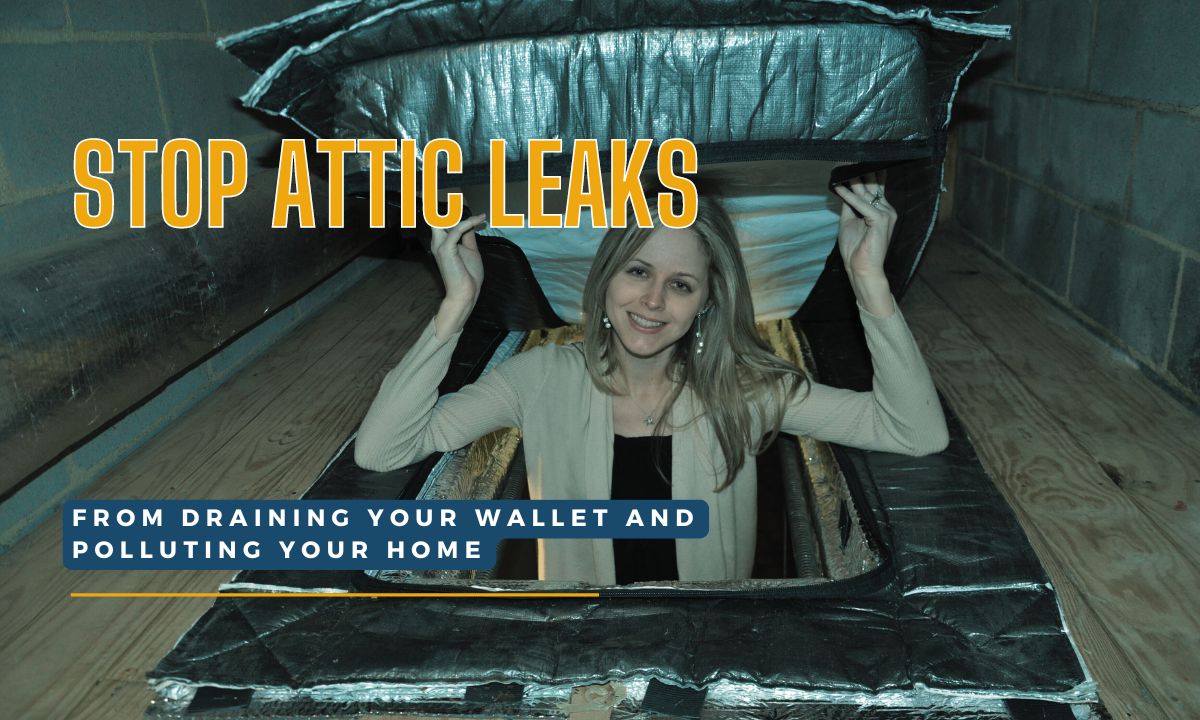
03 May Stop Attic Leaks from Draining Your Wallet and Polluting Your Home
Attic leaks might appear to be a minor inconvenience, but they can escalate into major issues if not addressed promptly. These leaks can compromise your home’s structural integrity, inflate your energy bills, degrade air quality, and foster mold growth. In this comprehensive guide, we will delve into the common causes of attic leaks, provide actionable solutions to stop them, and highlight the benefits of proactive prevention.
Table of contents
- Common Causes of Attic Leaks
- The Impact of Attic Leaks on Your Home
- Energy Efficiency Loss
- Identifying Attic Leaks Early
- Regular Inspection and Maintenance Tips
- How to Stop Attic Leaks
- Preventative Measures to Avoid Future Leaks
- Hiring a Professional vs DIY Repairs
- Costs of Repairs vs Long-Term Savings
- Conclusion
- FAQs
Common Causes of Attic Leaks
Identifying the root causes of attic leaks is essential for effective prevention. By understanding these causes, you can take early action to prevent costly repairs and unnecessary energy loss.
Roof Damage
Your roof serves as the primary defense against environmental elements. When it’s compromised, leaks can infiltrate your attic, causing damage to insulation, support beams, and drywall.
Missing or Damaged Shingles
Shingles are designed to protect your roof. Cracked, curled, or missing shingles create pathways for rainwater to enter your attic. Weather conditions such as strong winds and storms, along with age, can deteriorate shingles over time.
Cracked Flashing
Flashing, which is installed around chimneys, vents, and other roof penetrations, prevents water from seeping into your attic. When flashing cracks or corrodes, it creates gaps that allow water to enter, particularly around skylights and chimneys.
Poor Attic Ventilation
Inadequate ventilation can lead to moisture buildup in your attic, creating an ideal environment for mold and mildew growth. Clogged or improperly placed vents exacerbate this issue.
Improper Insulation
Insulation is crucial for maintaining indoor temperatures. Improperly installed insulation can lead to condensation and moisture buildup, which, over time, seeps into your walls and ceilings.
The Impact of Attic Leaks on Your Home
Attic leaks have far-reaching effects beyond just roof damage. They can cause significant problems throughout your home if left unchecked.
Structural Damage
Water is a powerful force that can severely damage your home’s structure. Even minor leaks can lead to substantial issues if not addressed in a timely manner.
Rotting Wood and Damaged Beams
Continuous moisture exposure causes wood to rot, weakening the support beams in your attic. This deterioration can lead to costly repairs, especially if it spreads to other parts of your home.
Ceiling Stains and Sagging
Leaks often result in unsightly ceiling stains. Over time, if these leaks are not addressed, the ceiling material can weaken and sag, potentially leading to collapse.
Mold and Mildew Growth
A damp attic is a breeding ground for mold and mildew. Once mold starts to grow, it can quickly spread to other areas of your home, causing property damage and health issues.
Health Risks
Mold spores can travel into your living spaces, leading to respiratory problems, allergic reactions, and severe health conditions for those with weakened immune systems.
Air Quality Degradation
Leaks combined with poor ventilation significantly degrade indoor air quality. Moisture and mold growth release pollutants into the air, affecting the overall atmosphere of your home.
Energy Efficiency Loss
A leaky attic not only increases repair costs but also drains your wallet through higher energy bills.
Higher Energy Bills
Moisture can affect your attic’s insulation, reducing its effectiveness. Consequently, your HVAC system must work harder to maintain a comfortable indoor temperature, resulting in higher energy costs.
HVAC System Strain
Leaks place additional strain on your HVAC system, causing it to operate longer to maintain temperature. This can lead to costly repairs or premature replacements.
Identifying Attic Leaks Early
Detecting leaks early is crucial to prevent extensive damage. Here’s what to look for:
Visible Signs to Look For
Water Stains on Ceiling
Water spots on your ceiling, particularly after storms, are strong indicators of leaks. These stains may start small but can rapidly expand if ignored.
Damp or Moldy Insulation
Inspect your attic insulation for dampness or mold. If it feels wet or appears discolored, water is likely entering your attic.
Unusual Sounds or Smells
Strange noises like dripping water or musty odors can signal a leak. Moisture accumulation in hidden areas often leads to mold growth that emits a distinctive smell.
Regular Inspection and Maintenance Tips
Inspect your attic twice a year, especially before and after the rainy season. Look for signs of moisture, insulation damage, or mold growth. Early detection simplifies and reduces the cost of repairs.
How to Stop Attic Leaks
Once a leak is identified, prompt action is necessary to mitigate damage.
Inspect and Repair Roof Damage
Replace Missing Shingles
Replace any missing or damaged shingles immediately to prevent further water infiltration and protect your attic.
Fix Flashing Around Chimneys and Vents
Ensure that the flashing around chimneys, vents, and roof penetrations is intact and properly sealed.
Improve Attic Ventilation
Install Ridge and Soffit Vents
Ridge and soffit vents promote airflow, removing hot, moist air from your attic and reducing condensation and leaks.
Ensure Proper Airflow in Your Attic
Proper ventilation allows for adequate airflow, helping to prevent moisture buildup.
Upgrade Insulation
Choose Moisture-Resistant Insulation
Select insulation materials that resist moisture to prevent water absorption and keep your attic dry.
Ensure Proper Installation to Avoid Gaps
Proper installation is crucial. Ensure that insulation is fitted correctly to avoid gaps where moisture can accumulate.
Preventative Measures to Avoid Future Leaks
Routine maintenance can prevent future attic leaks.
Regular Roof Inspections
Inspect your roof annually, especially after severe weather events. Early damage detection can prevent costly repairs.
Keep Gutters Clean and Functional
Clogged gutters can cause water to back up and seep into your attic. Regularly clean your gutters to ensure proper water diversion.
Ensure Proper Drainage Around the Home
Maintain your home’s drainage system to ensure water flows away from the foundation, preventing leaks in the attic and other areas.
Hiring a Professional vs DIY Repairs
Deciding between DIY repairs and hiring a professional depends on the damage’s severity.
When to Call a Professional
For widespread damage or multiple leaks, hiring a professional is advisable. They can perform thorough inspections and make lasting repairs.
DIY Tips for Smaller Repairs
For minor leaks, you can handle repairs yourself. Use proper materials and follow safety precautions when working on your roof or attic.
Costs of Repairs vs Long-Term Savings
While professional repairs may seem costly initially, they can save you thousands in long-term damage by preventing future leaks and extending your home’s lifespan.
Conclusion
Attic leaks can cause severe damage to your home and financial strain if left unchecked. Understanding their causes, recognizing early signs, and taking proactive measures can help you avoid costly repairs, improve energy efficiency, and maintain a healthy living environment. For optimal protection and energy savings, consider using attic zipper covers from AtticZipper.com.
Upgrade Your Home with Attic Zipper Covers
Prevent attic leaks and enhance your home’s energy efficiency with AtticZipper.com’s high-quality attic zipper covers. Our products provide a reliable seal, protecting your home from leaks, reducing energy costs, and improving overall comfort. Visit AtticZipper.com to explore our range of attic zipper covers and take the first step toward a more secure and energy-efficient home.
FAQs
What are the first signs of an attic leak?
The first signs include water stains on the ceiling, damp insulation, or a musty smell in the attic.
How often should I check my attic for leaks?
Inspect your attic twice a year, particularly after heavy storms or during seasonal changes.
Can attic leaks affect my home’s energy efficiency?
Yes, attic leaks can damage insulation, causing your HVAC system to work harder and increasing energy bills.
How much does it cost to fix an attic leak?
Minor repairs can cost around $200, while extensive damage may exceed $2,000, depending on severity.
Can mold from attic leaks be hazardous to my health?
Yes, mold can release spores into the air, causing respiratory issues and allergic reactions, especially for individuals with asthma or weakened immune systems.



